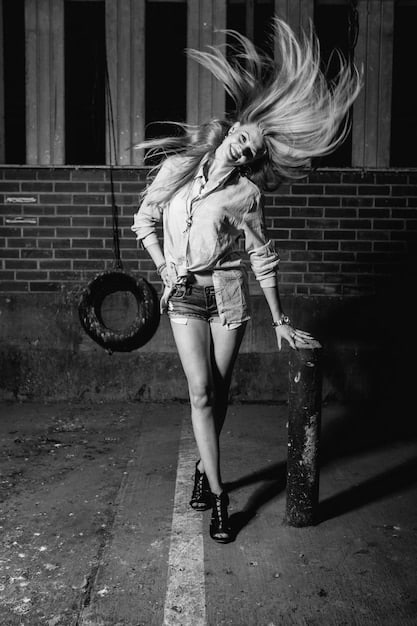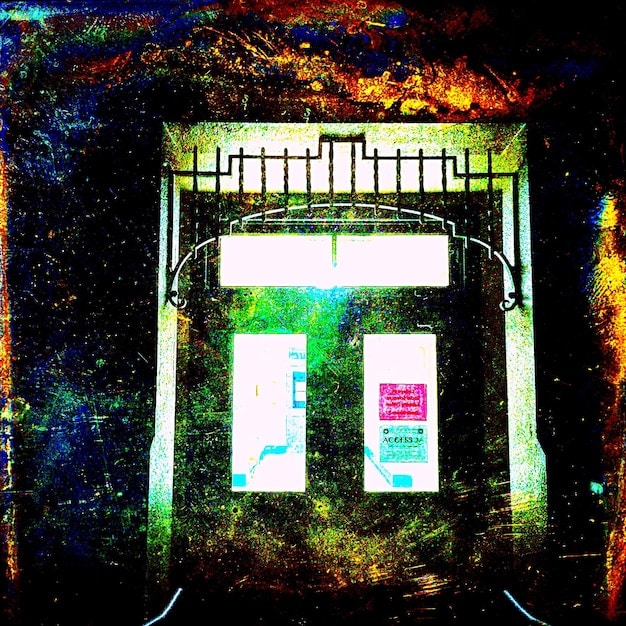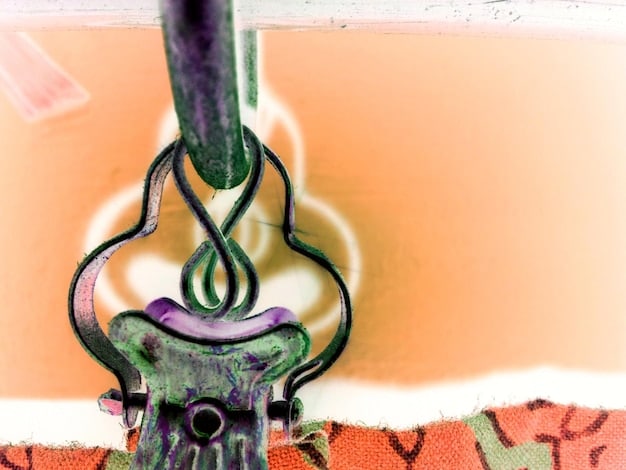From Punk to Post-Punk: US Alternative Music Lineage

The evolution of US alternative music scenes from punk to post-punk reflects a dynamic period of cultural rebellion and artistic innovation, tracing a lineage from raw dissatisfaction to sophisticated sonic explorations that reshaped musical landscapes and influenced subsequent generations.
The journey from the raw, rebellious energy of punk rock to the more nuanced, experimental soundscapes of post-punk marked a pivotal shift in the DNA of US alternative music. This transformation wasn’t a sudden break but a fluid, often contentious, evolution that reshaped sonic boundaries and cultural norms, laying the groundwork for countless genres to follow. Understanding this lineage — from the visceral urgency of early punk to the intellectual introspection of post-punk — is crucial to grasping the foundational elements of American alternative music scenes.
The Genesis of US Punk: A Sound of Disillusionment
The late 1970s saw the emergence of punk rock in the United States, a visceral reaction against the perceived excesses and complacency of mainstream rock. It wasn’t merely a musical genre; it was a cultural phenomenon characterized by its raw energy, DIY ethos, and a fiercely anti-establishment stance. This nascent movement gave voice to a generation disillusioned with economic stagnation, political corruption, and the perceived emptiness of consumer culture.
In cities like New York and Los Angeles, small, grimy clubs became the crucibles where punk’s furious energy was forged. Bands eschewed guitar solos and elaborate production, opting instead for short, fast, and loud songs that cut directly to the core of their frustrations. The simplicity of the music was often a direct challenge to the virtuosity that dominated rock music at the time, democratizing musical expression and inviting anyone with a guitar and a grievance to participate.
New York’s CBGB and The Ramones
CBGB, a dingy bar in Manhattan’s East Village, became the undisputed epicenter of the burgeoning New York punk scene. It was here that bands like The Ramones, Television, and Talking Heads honed their craft, developing distinct sounds that would go on to define the era. The Ramones, with their stripped-down, three-chord anthems and distinctive leather jackets, epitomized punk’s minimalist aesthetic and infectious energy.
- 🎸 **Ramones’ Impact:** Their rapid-fire songs, often under two minutes, became a template for punk’s brevity and intensity.
- 🎤 **CBGB’s Influence:** The club fostered a sense of community and gave nascent bands a vital platform.
- 🤘 **Anti-Establishment Message:** Punk lyrics often railed against societal norms, consumerism, and political apathy.
West Coast Aggression: The Rise of Hardcore
Simultaneously, a distinct strain of punk began to emerge on the West Coast, particularly in Los Angeles. This was a faster, more aggressive variant known as hardcore punk. Bands like Black Flag and the Dead Kennedys pushed the boundaries of speed and intensity, their music reflecting a darker, more nihilistic edge. The scene was characterized by its fierce independence and a strong sense of local identity, often tied to specific neighborhoods and skate cultures.
The ethos of hardcore was often even more DIY than its New York counterpart, with bands self-releasing records and organizing their own tours. This grassroots approach not only defied the music industry but also built a powerful, self-sustaining subculture that thrived on its outsider status. The raw power and unfiltered anger of hardcore resonated deeply with a segment of youth who felt unheard and disenfranchised.
The initial wave of US punk, while relatively short-lived in its purest form, created an undeniable ripple effect. It demolished existing musical conventions, popularized a DIY approach to art, and established a powerful precedent for self-expression outside the mainstream. Its raw energy and confrontational stance would directly inform the complex, often contradictory, evolution into post-punk.
The Post-Punk Pivot: Experimentation and Nuance
As the initial fury of punk began to wane, a new, more experimental sound emerged from its ashes: post-punk. This wasn’t a rejection of punk’s principles but rather an expansion of its artistic boundaries. While punk was about demolition, post-punk was about reconstruction, taking punk’s raw energy and applying it to broader musical and intellectual pursuits. It rejected punk’s self-imposed limitations on instrumentation and song structure, embracing a wider palette of sounds and influences.
Post-punk artists sought to explore darker, more complex themes, moving beyond simple protest chants to delve into introspection, existentialism, and social commentary. The music became less about three-chord simplicity and more about texture, atmosphere, and rhythmic innovation. Bass lines became more prominent and melodic, guitars often took on discordant or textural roles, and synthesizers began to creep into the soundscape, adding new layers of sonic possibility.
From Noise to Art: Blurring Genre Lines
Bands transitioned from the brash simplicity of punk to a more nuanced, art-rock sensibility. Post-punk drew from diverse influences, from funk and reggae rhythms to avant-garde classical music and electronic soundscapes. This eclecticism was a hallmark of the genre, allowing for a vast range of sounds and styles under the post-punk umbrella.
- 🎷 **Diverse Instrumentation:** Saxophones, keyboards, and other instruments less common in punk found their way into post-punk.
- 🎶 **Complex Rhythms:** Basslines became dominant, driving songs with sophisticated and often danceable grooves.
- 🖼️ **Artistic Aspirations:** Many post-punk bands embraced art school aesthetics and intellectual themes in their lyrics and imagery.
Key US Post-Punk Innovators
In the US, bands like Talking Heads, Pere Ubu, and Television, many of whom had roots in the initial punk scene, transitioned seamlessly into post-punk by incorporating more sophisticated arrangements and thematic depth. Talking Heads, for instance, infused their sound with African rhythms and intellectual lyrics, creating a unique, art-pop blend that was both accessible and challenging. Pere Ubu, from Cleveland, pushed the boundaries of experimental rock, incorporating avant-garde elements and industrial sounds into their music.
The evolution wasn’t always linear; some bands maintained elements of punk’s aggression while others leaned heavily into art-rock abstraction. What united them was a shared willingness to experiment, to defy expectations, and to challenge both musical and societal conventions. This period was marked by a creative explosion, with bands constantly pushing against perceived limits to forge new sonic territories.
Regional Hubs and Unique Sounds
While New York and Los Angeles were central to the punk and post-punk narratives, the vitality of US alternative music was also fostered in a multitude of regional scenes, each contributing its own distinct flavor. These local hubs, often characterized by small venues, independent labels, and close-knit communities, allowed for diverse musical growth, demonstrating that the alternative movement was far from monolithic.
The geographic spread of these scenes meant that bands were influenced by their immediate surroundings, leading to a rich tapestry of sounds. From the industrial landscapes of the Midwest to the academic environments of the Northeast, local conditions often shaped the artistic output, creating unique sonic identities that stood apart from the more established coastal sounds.
Midwest’s Gritty Realism: Cleveland and Minneapolis
The Midwest produced some of the most challenging and innovative post-punk. Cleveland bands like Pere Ubu and The Dead Boys showcased a raw, almost industrial sound that reflected the city’s grim sensibilities. Their music was often angular, dissonant, and lyrically complex, delving into themes of urban decay and alienation. In Minneapolis, bands like Hüsker Dü and The Replacements were instrumental in blending punk’s energy with more melodic sensibilities, paving the way for alternative rock.
- 🏭 **Industrial Influence:** Midwest bands often incorporated harsh, mechanical sounds, reflecting the region’s industrial heritage.
- 🤝 **Tight-Knit Communities:** Local scenes fostered strong bonds, with musicians often collaborating across different projects.
- 🎶 **Diverse Sounds:** From Pere Ubu’s experimentalism to Hüsker Dü’s melodic hardcore, the Midwest was a melting pot of styles.
Southern Sensibilities: Athens, Georgia
Athens, Georgia, emerged as an unexpectedly vibrant scene, a college town that birthed bands like R.E.M. and The B-52’s. Unlike the gritty realism of the Midwest or the urban angst of New York, Athens offered a more whimsical, often eccentric, take on alternative music. R.E.M. pioneered a jangly, melodic sound rooted in folk and pop, while The B-52’s blended new wave, surf rock, and kitsch aesthetics into a highly original, danceable package.
The laid-back, creative atmosphere of Athens allowed bands to develop their unique voices without the intense commercial pressures of larger music centers. This regional identity was crucial in diversifying the overall sound of US alternative music, proving that innovation could bloom far from the traditional music industry hubs. These regional distinctiveness highlighted the decentralization of musical innovation, proving that alternative music was a nationwide phenomenon, not just confined to a few major cities.

The DIY Ethos and Independent Labels
A driving force behind both punk and post-punk in the US was the unwavering commitment to the “Do It Yourself” (DIY) ethos. This principle was born out of necessity and a deep-seated distrust of the corporate music industry. Bands, frustrated by what they saw as inaccessible or exploitative traditional channels, took matters into their own hands, creating a parallel infrastructure for booking shows, recording music, and distributing their art.
This DIY approach was not just a practical solution; it was a philosophical statement, a rejection of mainstream commercialism and a celebration of independent creation. It empowered artists and fans alike, fostering a sense of community and shared purpose away from the glitter and glamour of the established music scene. The absence of major label interest in these unconventional sounds initially forced, then fostered, a truly independent ecosystem.
From Zines to Indie Labels: Building an Ecosystem
Independent record labels became the lifeblood of this burgeoning scene. Labels like SST Records (Black Flag, Minutemen), Dischord Records (Minor Threat, Fugazi), and Twin/Tone Records (The Replacements) emerged as a direct response to the lack of major label interest in punk and post-punk. These labels were often run by musicians themselves, prioritizing artistic integrity over commercial success. They operated on shoestring budgets, fostering direct relationships with artists and fans.
- 📰 **Fanzines:** Self-published magazines became crucial for communication, spreading news, reviews, and band information.
- 🏠 **House Shows:** Bands often played in basements and garages, creating intimate and unpolished performance spaces.
- 📦 **Mail Order:** Independent labels utilized mail order to reach fans across the country, bypassing traditional retail.
The Impact of Independent Radio and College Stations
Crucially, college radio stations played an indispensable role in disseminating punk and post-punk music. Unlike commercial stations, college radio had the freedom to experiment, playing unconventional tracks that would never see airplay on mainstream channels. These stations became vital tastemakers, exposing new bands to a dedicated and engaged audience, and helping to galvanize regional scenes into a national movement.
The symbiotic relationship between independent labels, fanzines, and college radio created a powerful, self-sustaining ecosystem that nurtured this new wave of music. It proved that commercial validation wasn’t necessary for artistic impact or cultural resonance. This independent spirit not only allowed punk and post-punk to flourish but also laid the blueprint for the entire indie music landscape that would follow, shaping how artists could operate outside corporate control for decades to come.
Fashion, Art, and Socio-Political Commentary
The punk and post-punk movements were far more than just musical genres; they were comprehensive cultural phenomena that permeated fashion, visual art, and socio-political discourse. They provided a fertile ground for dissent and self-expression, creating a distinct aesthetic that challenged societal norms and reflected the anxieties and aspirations of a generation. This holistic approach gave the movements a depth that transcended mere entertainment.
Fashion, in particular, became a powerful tool for visual rebellion. Ripped clothing, safety pins, spiked hair, and idiosyncratic makeup were not just random choices but deliberate statements against conformity, consumerism, and the polished image of mainstream culture. Each element of the punk and post-punk aesthetic was imbued with meaning, communicating solidarity, defiance, or artistic intention.
Fashion as Rebellion and Identity
Punk fashion, originating largely in the UK but quickly adopted and adapted in the US, was characterized by its anti-establishment, DIY aesthetic. It was often confrontational and provocative, designed to shock and challenge. Post-punk fashion, while still independent, evolved to be more diverse and artistic, often drawing inspiration from art movements, historical styles, and avant-garde theatre, reflecting the genre’s broader musical palette.
- 🖤 **Punk’s Anti-Fashion:** Ripped denim, leather jackets, band patches, and safety pins symbolized a rejection of consumer fashion.
- 🎨 **Post-Punk’s Eclecticism:** More experimental clothing, often incorporating elements of new wave, goth, and art school aesthetics.
- ✂️ **DIY Clothing:** Customization and self-made garments were a common way for individuals to express their unique identities.
Visual Arts and Thematic Depth
Album art, posters, and fanzines were crucial mediums for visual artists associated with these scenes. The artwork often mirrored the music’s themes, using deliberately primitive aesthetics for punk or more abstract, avant-garde designs for post-punk. Artists like Raymond Pettibon, known for his stark, unsettling drawings for Black Flag, captured the raw alienation of the hardcore scene. Other artists experimented with collage, stark photography, and graphic design to convey complex ideas.
Beyond aesthetics, both movements were deeply intertwined with socio-political commentary. Punk’s lyrics directly addressed issues like unemployment, class struggle, and government apathy (“No Future,” “White Riot”). Post-punk, while sometimes more abstract, still grappled with themes of alienation, surveillance, urban decay, and the anxieties of modern life, often with a more poetic or intellectual slant. This direct engagement with contemporary issues made the music resonate beyond just entertainment, positioning it as a significant cultural force capable of reflection and critique.
Legacy and Mainstream Influence
The reverberations of US punk and post-punk continue to be felt throughout contemporary music and popular culture. What began as a rebellious fringe movement eventually seeped into the mainstream, influencing countless bands across various genres and forever altering the landscape of popular music. The initial shockwaves created by these genres paved the way for the alternative boom of the 1990s and beyond, proving their enduring relevance.
The independent spirit, the willingness to experiment, and the raw authenticity championed by punk and post-punk artists set a new precedent. Major labels, initially dismissive, eventually recognized the commercial potential of these sounds, albeit often in a more diluted or polished form. This integration, while sometimes criticized as co-optation, also meant that the core ideas of alternative music reached a much wider audience.
Alternative Rock’s Ascendancy in the 90s
The 1990s saw alternative rock explode into the mainstream, largely thanks to bands like Nirvana, Pearl Jam, and Green Day, all of whom drew heavily from the foundations laid by punk and post-punk. Nirvana, in particular, brought the raw intensity and stripped-down aesthetic of punk to a global audience, demonstrating that angst and integrity could sell millions of records. Bands like Green Day sanitized punk’s rebellious spirit for a new generation, creating pop-punk anthems that dominated airwaves.
- 🎸 **Grunge:** A direct descendant of hardcore and noise rock, born in the Pacific Northwest.
- 🎤 **Pop Punk:** Blended punk’s energy with pop melodies, reaching massive commercial success.
- 🌟 **Independent Success:** The DIY ethic continued to inspire new generations of bands to control their creative output.
Enduring Influence on Contemporary Music
Today, the influence of punk and post-punk can be heard across a multitude of genres, from indie rock and electronic music to hip-hop and pop. The emphasis on authenticity, the DIY approach to recording and distribution, and the willingness to challenge commercial norms remain defining characteristics of independent music globally. Artists continue to sample, reference, and reinterpret the sounds and aesthetics born from these foundational movements.
Beyond sound, the cultural impact of punk and post-punk is evident in fashion, art, and even political activism. The spirit of questioning authority, embracing individuality, and building communities outside of dominant structures remains a powerful legacy. The lineage from punk to post-punk in US alternative music scenes is not just a historical curiosity; it is a living, breathing influence that continues to shape and inspire new generations of artists and fans.

Beyond Music: Cultural and Societal Impact
The journey from punk to post-punk in the US alternative music scenes was not confined to sound waves and concert halls; it triggered ripple effects that reshaped various facets of American culture and society. These movements provided platforms for marginalized voices, challenged established norms, and instilled a powerful sense of agency among young people. Their influence extended into independent media, social activism, and even the academic realm, prompting new discussions about art, identity, and rebellion.
From the outset, punk’s raw honesty and defiant attitude punctured the bubble of mainstream complacency, encouraging a critical perspective on consumerism, government, and societal structures. Post-punk, with its intellectual bent, deepened this critique by often employing ironic distance, complex narratives, and a more nuanced exploration of personal and collective anxieties. This evolution showcased a growing sophistication in how alternative music engaged with the broader world.
Empowering Counter-Culture Movements
Both punk and post-punk were instrumental in empowering counter-culture movements. They offered spaces where non-conformity was celebrated, fostering communities that provided solace and identity for those who felt disenfranchised by mainstream society. The DIY ethos, in particular, transcended music, inspiring independent publishing, self-produced films, and grassroots activism. Zines and independent record labels spurred a network of communication that bypassed corporate media, allowing diverse voices to reach broader audiences.
- ✊ **Anti-Establishment Stance:** Challenged authority and encouraged skeptical thinking towards dominant narratives.
- 🌈 **Inclusivity:** Provided platforms for LGBTQ+ artists, women, and artists of color, often before mainstream acceptance.
- 📚 **Grassroots Organizing:** Inspired independent publishing, zines, and community-centric art projects.
Shaping Independent Media and Art Scenes
The independent media landscape was significantly shaped by the innovative approaches pioneered during this era. Fanzines evolved into respected independent magazines, and small record labels grew into influential indie powerhouses. This cultural infrastructure developed organically from the ground up, proving that high-quality, impactful content could be created and disseminated without the backing of major corporations. This gave rise to new pathways for artistic freedom and expression.
Moreover, the aesthetic principles of punk and post-punk infiltrated visual arts, fashion design, and performance art. Artists drew inspiration from the raw, unpolished energy of punk or the intellectual, textural complexity of post-punk. This cross-pollination enriched the broader cultural tapestry, creating dynamic interactions between different artistic disciplines. The movements’ relentless questioning of artistic boundaries and societal expectations left an indelible mark, demonstrating the profound capacity of music to serve as a catalyst for widespread cultural and social change.
| Key Aspect | Brief Description |
|---|---|
| 🎤 Punk’s Raw Genesis | Emergence in late 70s US, characterized by raw energy, DIY ethos, and anti-establishment message. |
| 🧪 Post-Punk Evolution | Expansion of punk, embracing experimentation, diverse instrumentation, and complex socio-intellectual themes. |
| 🗺️ Regional Scenes | Unique local hubs like Cleveland and Athens fostered distinct sounds, enriching the genre’s diversity. |
| 🌐 Lasting Influence | Shaped alternative rock, indie music, and broader cultural movements, continuing to inspire. |
Frequently Asked Questions
Punk was primarily a reactive, minimalist movement focused on raw energy, brevity, and anti-establishment sentiments, often using simple three-chord structures. Post-punk, while retaining punk’s DIY spirit, expanded into more experimental territories, incorporating diverse instruments, complex rhythms, and intricate lyrical themes, moving beyond anger to embrace introspection and artistic exploration.
New York City, particularly around iconic venues like CBGB, was the birthplace of US punk. Los Angeles and its surrounding areas became a key hub for hardcore punk. Later, regional scenes in cities like Cleveland, Minneapolis, and Athens, Georgia, became crucial for fostering diverse and innovative post-punk sounds that contributed significantly to the genre’s breadth.
The DIY ethos was fundamental. It enabled bands to self-record, release music on independent labels, and organize their own tours, bypassing traditional music industry gatekeepers. This grassroots approach, coupled with the rise of fanzines and college radio, facilitated the widespread dissemination of these alternative sounds, fostering tight-knit communities and independent networks.
College radio stations were pivotal. Unlike commercial stations, they had the freedom to play unconventional and independent music, providing crucial exposure for punk and post-punk bands. This helped build dedicated fanbases, break new artists, and connect disparate regional scenes, making college radio an indispensable platform for the growth and influence of these alternative genres.
The legacy is immense. These genres laid the groundwork for alternative rock, indie rock, and grunge in the 1990s. Their emphasis on authenticity, artistic integrity, and independent creation continues to influence contemporary music across various genres. The DIY mentality and willingness to challenge mainstream norms remain central tenets for countless artists and subcultures today.
Conclusion
The trajectory from the raw, confrontational energy of punk to the innovative, introspective soundscapes of post-punk represents a profound narrative in US music history. This evolution, far from a simple genre shift, embodies a continuous exploration of identity, artistic freedom, and societal critique. The enduring legacy of these movements underscores their role not only in shaping musical styles but also in fostering a vibrant, independent cultural ecosystem that continues to inspire artists and audiences to challenge boundaries and embrace the power of authentic self-expression. Their influence, woven into the fabric of global subcultures, ensures their continued relevance.





